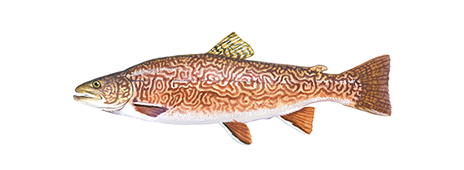
Tiger Trout
<p>The Tiger trout is a cross between a female brown trout (Salmo trutta) and a male brook trout.</p>

Region
Midwest, West
Catch ease
Easy
Habitat
River, Pond
HOW TO IDENTIFY A TIGER TROUT
The wavy tiger-like markings on the sides of this hybrid give it a unique beauty. It does not substantially resemble either of the parent species or any other salmonid. The overall color of the tiger trout is brownish on the back, lightening on the sides and belly to a golden yellow with a brown or orange wash. The back and sides both above and below the lateral line display large prominent sunshine yellow vermiculations, or worm-like markings, that are much more vivid and extensive than those of the brook trout.
WHERE TO CATCH TIGER TROUT
They have primarily been produced only on a small scale in private hatcheries for stocking in localized areas in several states however more and more states are stocking these fish. Theoretically, the tiger trout might occur anywhere that brook trout and brown trout inhabit the same waters.
The following list includes places where you can catch Tiger Trout:
| Outsides of Bends |
| Rivers and Streams |
| Dams and Falls |
| Eddies |
| Small Pointed Waves |
| Undercuts |
| Overhanging Trees and Bushes |
| Rock and Boulder Pockets |
| Drop-Offs |
| Merging Currents |
| Standing Waves |
| Current Edges |
How to catch Tiger Trout
Overall, the tiger trout is stockier and more aggressive than either parent and thus more easily caught. It is a surface feeder and is highly regarded by anglers in waters where it is stocked because of its aggressiveness to strike, its beautiful coloration, and strong fighting abilities. Its flesh is edible but not highly regarded by most. This fish can be taken with light spinning or fly tackle and will strike spoons, poppers and flies. The following are fishing methods used to catch this fish:
Tiger Trout lures, tackle & bait
The following are lures, tackle or bait that can be used to catch this fish:
